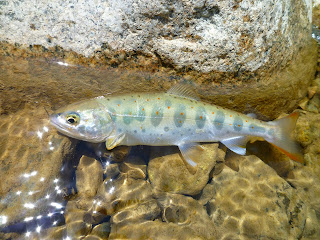This page is Part 2 of Mountain stream fishing.
In Part 1, I explained the importance of location and condition.
I'd like to talk about the tool or gear.
However, I'm still a novice at this fishing so that my mention here is only basic matter.
I need several or more years to acquire the perfect skill or technique.
It is not my modesty but it comes from the difficulty and profoundness of this fishing.
Besides, there are some discrepancies on Mountain stream fishing.
These make this fishing interesting.
<Gear>
1. Rod
~Discrepancy 1~
"If you want to come close the fishes, you should take some distance."
The rod is very simple, it is just a taper bar made from carbon material.
It is possible to expand to fish and contract to carry easy.
The length is around from 6 m to 8 m generally.
How many length is better?
The sellection depends on the fishing area, ex. at an open rapid, a deep pool, under trees and so on.
But it is better to use longer one as much as possible.
Because the fishes are very timid and nervous and fishing area is rather narrow.
They can realize the existance of fisherman so easy.
When they feel fishermen, they hide away behind rocks and don't eat any feed.
So that we have to keep some distance from them to avoid their wariness.
A long rod is an appropriate option.
Besides when we start fishing, we should not stand riverbank at first.
We should start from off shore.
And please take care not to reflect your shadow on river.
Consider the direction of sun.
 |
| Rod |
~Discrepancy 2~
"If you want to catch a big one, you have to use thin line."
Of course, if you hook a big fish with thin line, the line is easy to break.
To avoid breaking, it is better to use thicker line.
However, the big fish is experienced.
If the feed is flown unnaturally, they realize it is strange and don't eat it.
The thick line is easy to receive some disturbance, for example flows, waves, winds and so on.
As a result, the feed would be flown unnaturally.
And it makes difficult to detect a small fish biting.
The fish bitting is very small especially by a big fish.
To flow the bite naturally in stream, and to detect small biting, it is better to use more thin line.
So, which is better to use thin one or thick one??
It is up to you, and it depends on the condition.
We have to select more appropriate one to consider the situation.
When we expect to fish a big one, use thicker one.
When we expect to fish a middle one, use thinner one.
As a basic, we should use thinner line as much as possible.
Usually, we use from #0.2 (φ0.074 mm) to #0.6 (φ0.128 mm) line made from nylon.
It looks like a hair!
The selection of marker is easy.
The lighter one (easy to see) and the lighter one (small weight) is better.
Mainly, it is made from bright wool.
To avoid receiving disturbance, we cut it short after attaching to line.
 |
| Line, Marker and Hook |
4. Weight
~Discrepancy 3~
They live at the bottom of river. A heavy weight sinks faster to the bottom.
However, use a lighter weight as much as possible.
We have to sink the feed to the bottom because they are living there.
The flow of bottom is slower than the flow of surface.
So we understand the feed reaching to the bottom or not to see the speed of Marker flowing.
From this reason, it seems better to use a heavy weight, however, it is wrong.
The reason to use a lighter weight is similar to the case of line selection.
A heavy weight makes the motion or flow of feed strange or unnatural.
For a slow rapid, we use light one.
For a fast rapid, we use heavy one.
It depends on the location and condition of the fishing area.
Usually, we use from #3 (0.25g) , #1 (0.4g) to B2 (0.75g) weight made from iron.
5. Hook
I use a hook without barb.
Or other uses a soft barb hook.
Of course, it makes easy to miss hooking.
However, the damage to the fish is smaller than barb hook.
We sometimes fish a small fish.
In this case, we release the small one immedeately.
To keep limited natural resource, we use less damage hook.
It is Bushido, or Japanese chivalry, I think !!
< Continue Part 3 >


0 件のコメント:
コメントを投稿